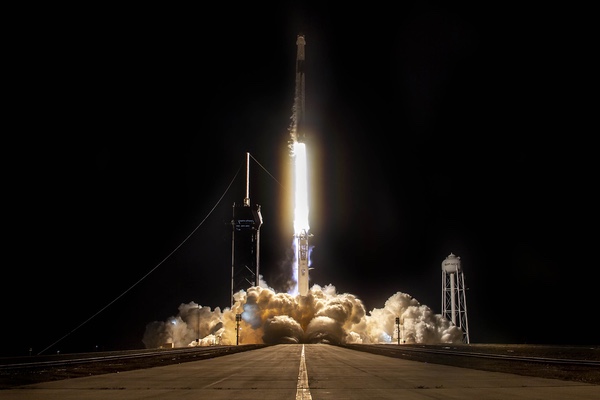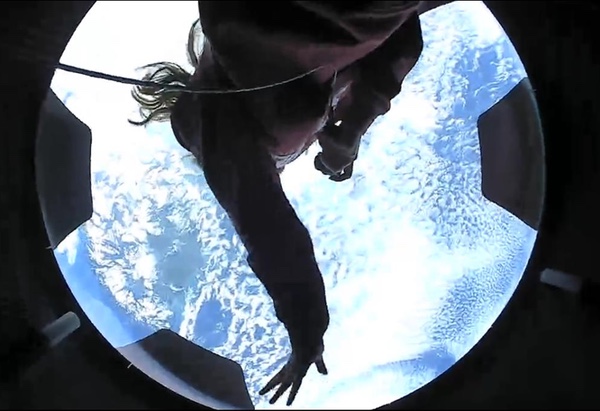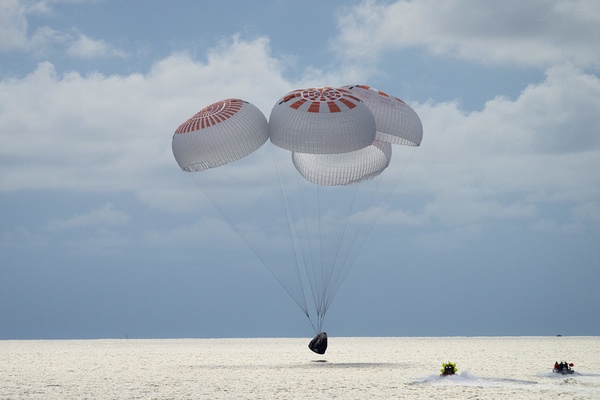An inspiration for private human spaceflightby Jeff Foust
|
| Inspiration4 stood out as something of an outlier, even in the unusual world of private human spaceflight. |
At the very least, Jared Isaacman wins the competition for longest, highest flight. The Inspiration4 mission spent nearly three days in space last week, from launch on a Falcon 9 just after 8 pm EDT Wednesday evening to splashdown off the coast from Cape Canaveral shortly after 7 pm EDT Saturday. Much of the 71-hour flight was spent at orbital altitudes of about 585 kilometers, well above the altitude of the International Space Station and higher than all but a handful of Space Shuttle missions. There would be no debate about the Kármán Line this time.
Inspiration4 stood out as something of an outlier, even in the unusual world of private human spaceflight. Blue Origin and Virgin Galactic have bene trying to build up sustainable businesses in suborbital spaceflight, using them as steppingstones for bigger ambitions (orbital spaceflight and beyond for Blue Origin, high speed point-to-point travel for Virgin Galactic.) Companies like Axiom Space and Space Adventures have been buying seats on orbital missions, and now entire orbital missions, to create a regular series of flight opportunities that could lead to commercial space stations.
By contrast, Inspiration4 was a one-off mission, one that looked a bit like a stunt. The mission was billed as a fundraiser for St. Jude Children’s Research Hospital, with the goal of raising $100 million, plus another $100 million Isaacman was donating. But that always seemed more like an excuse or justification for the flight rather than a reason to do so: after all, if Isaacman wanted to donate to St. Jude, it would have been faster and more effective to simply donate the money he was spending on the mission to the hospital directly.
There was also the hype factor. Inspiration4 made special arrangements with Time magazine for coverage of the mission, which included a cover story for the magazine and a documentary series airing on Netflix. The cover story in August featured the bold claim “Three Days That Could Change Humanity.” (Some subscribers got a different cover for that issue, one about the aftermath of the January 6 insurrection at the Capitol; something arguable more influential that a private spaceflight.)
But even if Inspiration4 seemed like an outlier, it also served as a pathfinder. It would be SpaceX’s first private human spaceflight and just its fourth crewed mission overall, after the launches of Demo-2, Crew-1, and Crew-2 for NASA’s commercial crew program. Both NASA and other commercial customers of SpaceX would be watching closely.
“It’s another opening up of space,” said NASA administrator Bill Nelson during an appearance at the Humans to Mars Summit by Explore Mars the day before the scheduled launch. He called it proof of NASA’s broader strategy to transition the agency’s operations in low Earth orbit to the private sector to allow it to focus on exploration of the Moon and Mars. “It’s another example of where we’d like to go in Earth orbit eventually.”
| “It’s another opening up of space,” Nelson said. “It’s another example of where we’d like to go in Earth orbit eventually.” |
“We are all following the Inspiration4 mission as closely as any fan of the growth of human space exploration,” Axiom Space spokesperson Beau Holder said the day before launch. “It brings new awareness and interest to commercial spaceflight and that is a positive thing for not only our own missions, but the efforts of everyone across the industry.”
Despite all the hype and attention, the launch itself turned out to be free of drama. The four-person crew of Isaacman, Hayley Arceneaux, Sian Proctor, and Chris Sembroski—assembled by March through a variety of contests and selection processes—rolled out to the pad in white Teslas and boarded the Crew Dragon spacecraft Resilience. Weather cooperated, as did the vehicle, and, 12 minutes after an on-time liftoff from Kennedy Space Center’s Launch Complex 39A, Resilience was in orbit.
 The Falcon 9 launching Inspiration4 lifts off from the Kennedy Space Center. (credit: SpaceX) |
The mission itself seemed like a hodge-podge of activities. Before the flight, Inspiration4 played up the fact that they would do biomedical research while on the mission, although it wasn’t clear how useful data collected of four people over three days would be compared to activities on the space station. They held a video call with patients at St. Jude. But they also virtually rang the closing bell of the New York Stock Exchange and Isaacman made what a sportsbook claimed were the first bets on sporting events placed from space (he took the over in Thursday night’s New York Giants-Washington Football Team NFL game and won; we’ll have to wait to see about his bet on the Philadelphia Eagles winning the Super Bowl.)
In contrast to the hype leading up to the flight, there were few details made public during their first day in orbit. “Just spoke with @inspiration4x crew. All is well,” SpaceX’s Elon Musk tweeted Thursday, one of the few updates that day. On Friday, though, the crew made a brief live video appearance, showing off the spacecraft and its cupola, a special viewing window installed in place of the docking mechanism in the nose of the capsule. Alas, the video session took place while the spacecraft was in orbital night, and internal reflections from lighting in the spacecraft washed out the view.
Nonetheless the cupola was a hit among the crew. “We have been spending so much time in this cupola,” Arceneaux said. “We can put our head in and fit multiple crew members. We see the entire perimeter of the Earth and it gives such an incredible perspective.”
After that call Friday afternoon, the mission geared up for its return. Resilience lowered its orbit to gear up for reentry, leading up to a splashdown Saturday evening as drama-free as the launch (or, at least, as free of drama as any launch or reentry can be.) By Monday, the four-person crew was already on the interview circuit, speaking with NBC News.
“Each of us have been changed in a way that maybe we didn’t expect,” Sembroski said in that interview. “And for me it was being able to see the earth in a way that made me realize there is so much to see in person that I need to go and find those places and explore more.”
The crew of Inspiration4 may have been changed, as one would expect from a life-altering experience like spaceflight, but did it change humanity, as Time predicted? Maybe not, but the commercial spaceflight industry may have changed as a result.
| “The amount of people who are approaching us through our sales and marketing portals has actually increased significantly,” said SpaceX’s Reed. |
The mission showed that a crew comprised entirely of non-professional astronauts (sometimes, if erroneously, called “all-civilian” by the mission and some media outlets) could fly to space safely and successfully, with only about six months of training. While both Isaacman and Proctor are pilots, including extensive experience by Isaacman flying high-performance jets in air shows, it seemed the two did very little “piloting” of the spacecraft during the three-day trip.
“What do you define as piloting, right?” said Inspiration4 mission director Todd Ericson in a call with reporters shortly after splashdown. He described it to flying a modern airliner with extensive use of autopilot, with the pilots monitoring and ready to step in if needed. “So they did do piloting, but it’s not in-the-loop piloting, like it would be on a Soyuz.”
 Inspiration4 crew member Hayley Arceneaux in the cupola of Crew Dragon, with Earth in the background. (credit: SpaceX) |
Some emphasized that the mission demonstrated that ordinary people could go in space, although previous space tourism missions had already proven that (while people who purchased seats on Soyuz flights through Space Adventures may have been extraordinarily wealthy, physically there were far more ordinary than the typical professional astronaut.) An exception might be Arceneaux, a childhood cancer survivor who has a prosthetic implant in one leg as a result of that treatment; she reported no issues.
That included what’s known as space adaptation syndrome, or spacesickness. “We expected sort of a NASA-standard level of space adaptation syndrome when you first get to orbit,” Ericson said. At least half of NASA astronauts have reported some degree of spacesickness in their first days in orbit. “We were pretty much tracking on target with what NASA astronauts do. What I think personally is wonderful about that is that it shows average men and women are not any more or less prone to space adaptation syndrome than NASA astronauts.”
Inspiration4 is something of a pathfinder for future commercial orbital missions. While a one-off in terms of the specifics of how it was put together—Isaacman hasn’t given any indications he wants to turn this into a business separate from his online payments company, Shift4 Payments, that made him a billionaire—it does provide a template for how such missions can be run in the future.
“For future missions, it will always go back to that question, do they know what they need to know to keep themselves safe and keep the public safe?” said Benji Reed, senior director of human spaceflight programs at SpaceX. “I think this one set a pretty good bar for what we want to do.”
Reed said before the launch that SpaceX would look for ways to revise and streamline the training program. A long-term goal is to get to an “airline-like” model with minimal training, he said, “but how we’ll evolve to that stage we’ll see.”
That might have limited effect on some other commercial missions, like those Axiom Space plans to fly to the space station. “As Axiom’s private missions are planned to visit ISS and with profiles more closely approximating previous government ones, a closer analogue for lessons learned would be the NASA crew missions,” Axiom’s Holder said before the launch.
But Reed suggested there is growing interest in even missions like Inspiration4, where people spend several days in orbit but don’t dock to the ISS. “The amount of people who are approaching us through our sales and marketing portals has actually increased significantly,” he said.
| ““I think if orbital spaceflight is just an exclusive domain of a couple of countries in the select few, I don’t know how far we’re gonna get,” Isaacman said. |
Reed offered no details on who was approaching SpaceX, but suggested the company could support as many as six Crew Dragon missions a year. With NASA demand currently at two missions per year, as well as two opportunities a year for private missions to the ISS, that would suggest interest in a couple missions a year like Inspiration4, spending a few days in orbit before coming back home.
“I think if orbital spaceflight is just an exclusive domain of a couple of countries in the select few, I don’t know how far we’re gonna get,” Isaacman said in that NBC News interview after splashdown. “So I think having organizations like SpaceX that are working very hard to drive down the cost of spaceflight, to make it more accessible for others, so all of us can go out and journey among the stars.”
SpaceX, of course, wants to eventually transition from Crew Dragon to Starship, although that shift will likely take longer than the aspirational schedules set by the company (the first orbital Starship test flight is likely to slip to next year because of the FAA environmental review and licensing process.) A steady stream of commercial Crew Dragon missions might offer a steady stream of revenue for SpaceX and open eyes to the possibilities of what such commercial missions can enable for tourism, research, or other commercial activities in orbit. Maybe the long-term winner of the billionaire space race this year was the person who stayed on Earth: Elon Musk.
Note: we are using a new commenting system, which may require you to create a new account.
